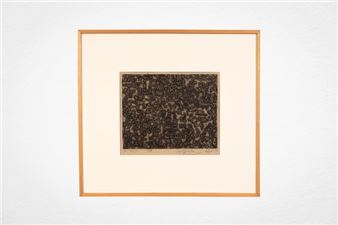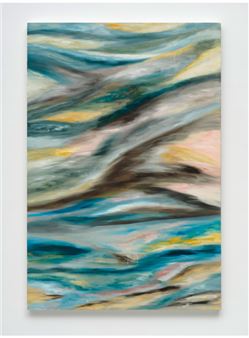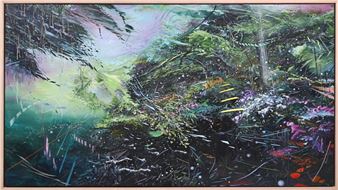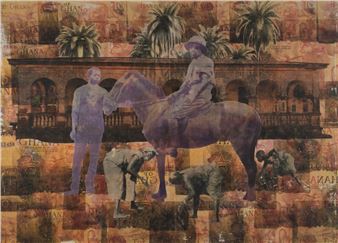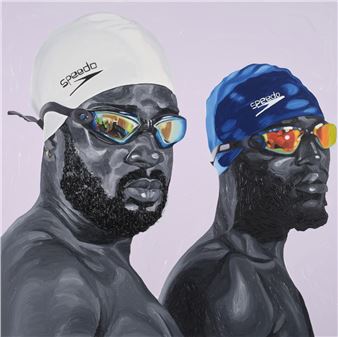Thameur Mejri: Eroded Grounds
Eroded Grounded is presented with allusions to a theatre or crime scene in which a play is taking place in suspension, ethereal and more readable. Although the colours have become more vivid, none of them manage to dominate Mejri’s compositions. Each canvas has become a battlefield where colours clash and canvases are like a burning landscape where everything is at war. Mejri’s colours have become more explicit, and reduced to, primary palettes of blues and hues of vermilion that antagonise each other on canvas. The distribution of colours seems to evoke the mapping of a territory in tension, occupied in a precarious way by forces in permanent conflict. Thameur Mejri's chromatic variations are like a tribute to the theorists of colour and support Wassily Kandinsky's criticism of materialism, in favour of understanding of the world, by form and colour, which have the ambition to touch the spiritual. His palette sometimes recalls great moments of modern and contemporary painting, such as Jasper Jones' Map (1961), and his orange-reds in contrast to azure blues borrow just as much from Goethe's and Johannes Itten's theories of colour, referring to the principles of depth sensations and the dynamism of the composition, based on the juxtaposition of warm and cold colours. This dynamism is not only a compositional effect but induces a tension that is completely instrumentalized by the artist since it is a question of assuming, through colour, confrontation, opposition and, as we see later, violence and chaos.
Thameur Mejri's paintings are full of narrative elements that function as if they were rebuses. Objects exist for what they are supposed to represent, as such, they are fragments of bodies, bones. However, another level of reading is played out on a pictographic scale. The pictogram is a graphic representation of a concept intended to embody a use or function in the public environment. These images have a symbolic function but must be identifiable by everyone, spontaneously, because they indicate the principles of danger, urgency and attitude. If their recognition must be obvious, it is nevertheless part of a language that, through images, can claim to be universal, but it is precisely here that the artist provokes his spectator. This rebus, which is composed, recomposed and decomposed, brings up banal, everyday elements (at least in the media), and this is how a television, a telephone, a gas can, a knife, a helicopter, a saw, a shovel, scissors, an aircraft and, above all, this omnipresent human skull emerge in the composition. The viewer may feel uneasy because most of the elements refer to communication, destruction and war. The recurring soccer ball in his paintings and the presence of children's drawings that refer to the artist's lost innocence will only reinforce this unease.

Recommended for you
Eroded Grounded is presented with allusions to a theatre or crime scene in which a play is taking place in suspension, ethereal and more readable. Although the colours have become more vivid, none of them manage to dominate Mejri’s compositions. Each canvas has become a battlefield where colours clash and canvases are like a burning landscape where everything is at war. Mejri’s colours have become more explicit, and reduced to, primary palettes of blues and hues of vermilion that antagonise each other on canvas. The distribution of colours seems to evoke the mapping of a territory in tension, occupied in a precarious way by forces in permanent conflict. Thameur Mejri's chromatic variations are like a tribute to the theorists of colour and support Wassily Kandinsky's criticism of materialism, in favour of understanding of the world, by form and colour, which have the ambition to touch the spiritual. His palette sometimes recalls great moments of modern and contemporary painting, such as Jasper Jones' Map (1961), and his orange-reds in contrast to azure blues borrow just as much from Goethe's and Johannes Itten's theories of colour, referring to the principles of depth sensations and the dynamism of the composition, based on the juxtaposition of warm and cold colours. This dynamism is not only a compositional effect but induces a tension that is completely instrumentalized by the artist since it is a question of assuming, through colour, confrontation, opposition and, as we see later, violence and chaos.
Thameur Mejri's paintings are full of narrative elements that function as if they were rebuses. Objects exist for what they are supposed to represent, as such, they are fragments of bodies, bones. However, another level of reading is played out on a pictographic scale. The pictogram is a graphic representation of a concept intended to embody a use or function in the public environment. These images have a symbolic function but must be identifiable by everyone, spontaneously, because they indicate the principles of danger, urgency and attitude. If their recognition must be obvious, it is nevertheless part of a language that, through images, can claim to be universal, but it is precisely here that the artist provokes his spectator. This rebus, which is composed, recomposed and decomposed, brings up banal, everyday elements (at least in the media), and this is how a television, a telephone, a gas can, a knife, a helicopter, a saw, a shovel, scissors, an aircraft and, above all, this omnipresent human skull emerge in the composition. The viewer may feel uneasy because most of the elements refer to communication, destruction and war. The recurring soccer ball in his paintings and the presence of children's drawings that refer to the artist's lost innocence will only reinforce this unease.
Artists on show
Contact details


 ARTISTS
ARTISTS







